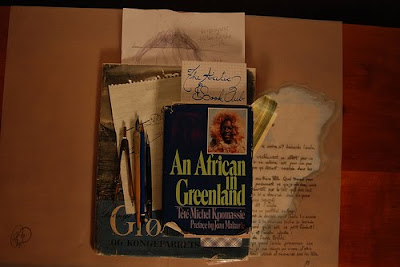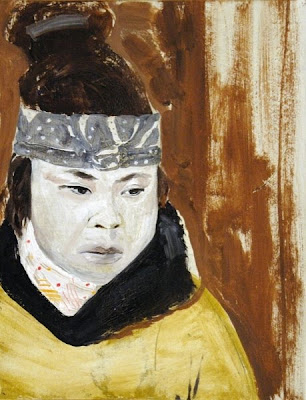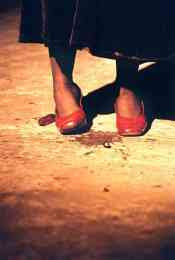
This autumn, Flux Factory and EFA Project Space presented Arctic Book Club in Manhattan. Curated by Jean Barberis and Michelle Levy, the exhibition was the result of an epic several-month long journey by a group of artists responding to Tété-Michel Kpomassie’s book, An African in Greenland.
An African in Greenland recounts the author’s pilgrimage from his native Togo to Greenland. Fascinated with the distant Arctic, Kpomassie embarked on a ten-year journey across Africa and Europe, working as a translator along the way, and eventually saving enough money to complete his odyssey.

In the Spring of 2009, Flux Factory and EFA assembled a cross-disciplinary group of artists to respond to Kpomassie’s book. Those selected were Amber Cortes, Jenelle Covino, The Green and Bold Cooperative, Katerina Lanfranco, Fabienne Lasserre, Valerie Piraino, Greg Pond, Annie Reichert, Julian Rogers, Ranbir Sidhu and Christopher Ulivo. They met regularly as a book club, and upon completion of the book, they all created new work inspired by Kpomassie’s narrative.

Some artists responded very closely to the text. Members of The Green & Bold Coöperative (McDavid Moore, Matthew Gribbon, Steven Thompson) produced a hand-written transcription of the original French text L’Africain Du Groenland. The work was conducted live within a complex installation comprising four work benches protruding from what appeared to be a large stack of boulders. In Nomadic Work Desk w/ Approximate Lodestone (Exhibition Format) the artists took their cue from the Inuit hospitality demonstrated in the book, and broke off from their calligraphic labour to engage gallery visitors in conversation and offer coffee in a service modelled on the “Kaffenik” of the Greenlanders.
 Other artists used the opportunity to explore the Arctic landscape. Katerina Lanfranco’s work reflects the extreme scales adopted by the elements, from the microscopic and elusive snow flake to the massive iceberg. Glacial Specimens (flame worked glass with clay and acrylic paint) consists of several small mixed media glass sculptures which capture the ephemeral nature of snow and ice crystals.
Other artists used the opportunity to explore the Arctic landscape. Katerina Lanfranco’s work reflects the extreme scales adopted by the elements, from the microscopic and elusive snow flake to the massive iceberg. Glacial Specimens (flame worked glass with clay and acrylic paint) consists of several small mixed media glass sculptures which capture the ephemeral nature of snow and ice crystals.  Midnight Sun, (hand-cut paper, 80 inches high) is a large paper-cut sculpture of an isolated iceberg seen in silhouette. A complex web of positive and negative spaces and shapes imply the angular ice forms and the contrast of dark and light are symbolic of the region’s Polar Night (total darkness) and Midnight Sun (total light). The form, like Greenland itself, drifts alone in the ocean and exists partially above and below water.
Midnight Sun, (hand-cut paper, 80 inches high) is a large paper-cut sculpture of an isolated iceberg seen in silhouette. A complex web of positive and negative spaces and shapes imply the angular ice forms and the contrast of dark and light are symbolic of the region’s Polar Night (total darkness) and Midnight Sun (total light). The form, like Greenland itself, drifts alone in the ocean and exists partially above and below water.  Christopher Ulivo designed a theatrical tribute to the story through a shadow puppet theatre. Rather than attempting to imitate Kpomassie’s style as storyteller, or engage in critical commentary, Ulivo chose to pay homage to the text by reworking it as a script for a shadow puppet show. As Ulivo developed his project, he realised that the puppet show was dramatically effective, not only because it conveyed the story directly, but also because its absolute dependence on the contrast between light and the absence of light is in direct correlation to Greenland’s black winters and endless summers. The naïve, playful characteristic of the medium was also important to the artist: “There are repeated references in the book to ways in which the Inuit entertain each other in so barren a place. Tété’s vivid descriptions of dances, birthday parties and Christmas festivities all have the feeling of homespun craftiness and companionship. I hope our show can channel some of the spirit of Inuit mirth.”
Christopher Ulivo designed a theatrical tribute to the story through a shadow puppet theatre. Rather than attempting to imitate Kpomassie’s style as storyteller, or engage in critical commentary, Ulivo chose to pay homage to the text by reworking it as a script for a shadow puppet show. As Ulivo developed his project, he realised that the puppet show was dramatically effective, not only because it conveyed the story directly, but also because its absolute dependence on the contrast between light and the absence of light is in direct correlation to Greenland’s black winters and endless summers. The naïve, playful characteristic of the medium was also important to the artist: “There are repeated references in the book to ways in which the Inuit entertain each other in so barren a place. Tété’s vivid descriptions of dances, birthday parties and Christmas festivities all have the feeling of homespun craftiness and companionship. I hope our show can channel some of the spirit of Inuit mirth.” Fabienne Lasserre created an installation made of human hair and plaster (Untitled). Long, dark hair hung down the gallery wall, overflowing onto the floor. The hair was covered in a thin layer of white poured plaster. Through the fluid texture of the plaster the disorderly and fibrous texture of the hair was visible; there were stark contrasts between the dark hair and the white plaster, between the shagginess of the hair and the smoothness of the plaster. Formalism and process, idealism and goofiness, purity and corruption exist in mutual agitation. The work drew inspiration from a similar tension in Kpomassie’s account of Greenland, which displays a contrast between the whiteness, the stillness and the beauty of the landscape and the dirty, visceral lifestyle of its inhabitants. Kpomassie constantly shifts from descriptions of faeces, guts, and blubber, to quasi-spiritual encounters with the environment.
Fabienne Lasserre created an installation made of human hair and plaster (Untitled). Long, dark hair hung down the gallery wall, overflowing onto the floor. The hair was covered in a thin layer of white poured plaster. Through the fluid texture of the plaster the disorderly and fibrous texture of the hair was visible; there were stark contrasts between the dark hair and the white plaster, between the shagginess of the hair and the smoothness of the plaster. Formalism and process, idealism and goofiness, purity and corruption exist in mutual agitation. The work drew inspiration from a similar tension in Kpomassie’s account of Greenland, which displays a contrast between the whiteness, the stillness and the beauty of the landscape and the dirty, visceral lifestyle of its inhabitants. Kpomassie constantly shifts from descriptions of faeces, guts, and blubber, to quasi-spiritual encounters with the environment. Annie Reichert’s contribution to the Arctic Book Club was Souvenir Desk, an installation comprising a wooden desk in which the drawers were filled with mementos of Kpomassie's journey. The desk was a found object that had been painted over several times by its previous owner. The artist sanded down the negative space around succeeding layers of grey, blue and white in order to reveal a topographic map of Greenland. The compact piece of furniture, comparable to one found in the cabin of a ship, was evocative of the physical space where an explorer would record his travel log. The desk also functioned as a metaphor for the writer’s mental space as he reconstructs his journey through memory and reflection.
Annie Reichert’s contribution to the Arctic Book Club was Souvenir Desk, an installation comprising a wooden desk in which the drawers were filled with mementos of Kpomassie's journey. The desk was a found object that had been painted over several times by its previous owner. The artist sanded down the negative space around succeeding layers of grey, blue and white in order to reveal a topographic map of Greenland. The compact piece of furniture, comparable to one found in the cabin of a ship, was evocative of the physical space where an explorer would record his travel log. The desk also functioned as a metaphor for the writer’s mental space as he reconstructs his journey through memory and reflection.

.jpg)





